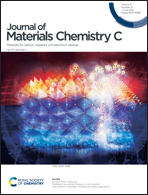Improving the performance of organic solar cells by side chain engineering of fused ring electron acceptors†
Abstract
The side chain engineering of photoactive materials is one of the most commonly used molecular design strategies for developing high performance organic solar cells (OSCs). Herein, two alkyl (or alkoxyl) chains, corresponding to 4TIC-C8-2F and 4TIC-OC8-2F, are introduced to the two outmost thiophene rings of the A–D–A type fused ring electron acceptor (4TIC-2F). We demonstrate that the molecular orientation, crystallinity and blend film morphology can be effectively regulated by side chain engineering. Moreover, the introduction of the flexible chains can also lead to reduced energy loss of photovoltaic devices and give rise to a higher open-circuit voltage. The power conversion efficiencies (PCEs) of the PM6:4TIC-C8-2F and PM6:4TIC-OC8-2F based solar cells are 10.75% and 10.13%, respectively, higher than the PM6:4TIC-2F based devices (10.03%). Furthermore, the optimized devices based on PM6:4TIC-C8-2F give an enhanced PCE of 12.65%. Our results have revealed that side chain engineering is an efficient molecular design strategy in developing high performance small molecular acceptors.



 Please wait while we load your content...
Please wait while we load your content...